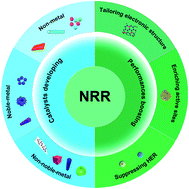Aqueous electrocatalytic N2 reduction for ambient NH3 synthesis: recent advances in catalyst development and performance improvement
Abstract
Electrochemical N2 reduction has emerged as an environmentally benign alternative to the Haber–Bosch process for sustainable NH3 synthesis under ambient reaction conditions, and considerable recent attention has focused on electrocatalytic NH3 synthesis from N2 and H2O in aqueous media. In this Minireview, we summarize the recent advances in the development of electrocatalysts for the N2 reduction reaction (NRR). Strategies to boost the NRR performances are also discussed. Perspectives for further research directions are provided finally.

- This article is part of the themed collection: 2020 Journal of Materials Chemistry A most popular articles


 Please wait while we load your content...
Please wait while we load your content...